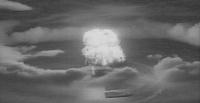

I. MOTIVATION
Seismic networks provide a primary technology for monitoring compliance with a Comprehensive Test Ban Treaty (CTBT). The design goal of the network is the identification of possibly clandestine explosions detonated primarily below the earth's surface and secondarily in the oceans. Complementary technologies such as infrasonic, hydroacoustic and radionuclide monitoring supplement the seismic monitoring covering explosions in the atmosphere and oceans (Arms Control and Nonproliferation Technologies, Second Quarter, 1994).
Seismic sources that will produce detectable signals will be both natural and man-made in origin. Naturally occurring events include earthquakes, most of which are beneath the oceans or deeper than it is possible to drill, and volcanic eruptions. Accurate locations of such events to depths of beyond 10 km precludes further consideration of these events in the context of monitoring compliance.
Man-made or induced events include the great range of applications using conventional explosives for mining and excavation, rock burst and collapses associated with underground mining operations and induced earthquakes associated with the injection of fluids into the crust, often in secondary oil recovery. Although these events are relatively small in size (less than magnitude 4) they may produce signals similar in size to the smallest signals from a nuclear explosion, possibly detonated in an evasive way. Each of these different sources are shallow enough in depth that simple locations will not be sufficient to identify the source type. The remainder of event identification relies on distinguishing features of the seismic waveforms, possibly in conjunction with other monitoring technologies. The Non-Proliferation Experiment has focused attention upon the difficult problem of distinguishing, with seismic measurements, a contained nuclear explosion from a single fired chemical explosion (Denny and Zucca 1994). The number of ambiguous events produced by a monitoring system can only be quantified through the testing of a monitoring system (such as is being done during the Group of Scientific Experts Technical Test 3). Procedures for minimizing the number of questionable events and developing an information/experience base to decrease ambiguities with time is needed.
Following the work of Reamer et al., 1992, this paper reports on efforts to document experimentally, the physical processes in the near-source region of mining explosions for the purposes of unambiguously constraining the important characteristics that generate seismic waves. The primary goal of this work is quantification of the relative and absolute generation of compressional, shear and surface waves by different types of mining explosions and the assessment of the uniqueness of these signals for identification purposes. Physical processes that accompany these explosions include the directly coupled energy from the explosive shock, the expansion of gas accompanying the explosion source, spall or tensile failure of the free surface above and/or in front of the source and material casting.
Mining explosions are designed for a variety of purposes including the
fragmentation and movement of materials. The blast design is dependent on
the particular application intended and the material properties of the rock.
The
range of mining applications from hard rock quarrying to coal exposure to
mineral recovery leads to a great variety of blasting practices. A common
component of many of the sources is that they are at the earth's surface and
thus can be documented by camera or video. Although our primary interest is
in the regional seismic waveforms these blasts generate, the visual
observations of the blasts provide important constraints that can be applied to
the physical interpretation of the seismic source function. In particular, high
speed images can provide information on detonation times of individual
charges, the timing and amount of mass movement during the blasting process
and, in some instances, evidence of wave propagation away from the source.
All of these characteristics can be valuable in interpreting the equivalent
seismic source function for a set of mine explosions and quantifying the
relative
importance of the different processes, thus leading to the establishment of
techniques for identifying these source types from seismic waves that have
propagated to regional distances.
Combination of waveform measurements, usually made at a limited number of locations, with time varying spatial data such as the imagery of the explosive process produces data sets of greatly increased volume. A single video frame can be nearly one megabyte before compression. Since it is the determination of the seismic source time function that is the goal of these studies, the time varying visualizations are useful for interpretation purposes. Representative single data frames are provided in this text as pointers to time varying visualizations of these processes that can be down loaded over the World Wide Web and viewed. The still imagery is available in JPEG and GIF format, while the time varying imagery is in MPEG format. Both of these formats take advantage of data compression techniques.
A secondary goal of this paper is an investigation of the utility of combining multiple types of data into a coherent form for interpretation. We present in this paper some preliminary results that try to combine multiple data sets from mining explosions - such as ground motion data, video of the blasts, acoustic signals, individual explosion timing, spatial characterization of the explosions and three dimensional structure with models of these processes - in order to constrain our physical understanding of the source processes. A discussion of the processing steps, summary of some results and consideration of the implications is included.
Go to Table of Contents or Next Section